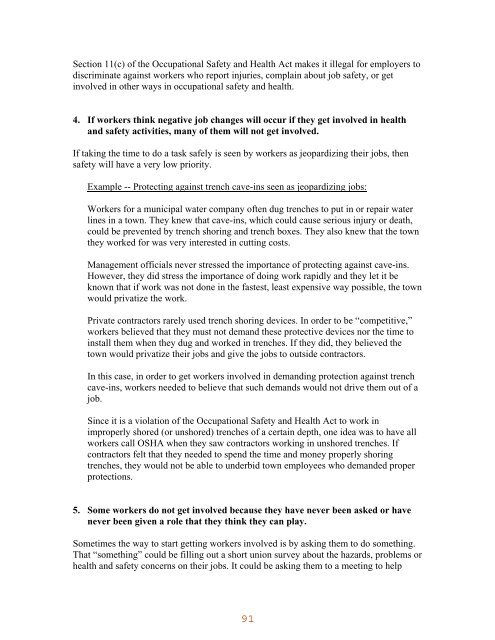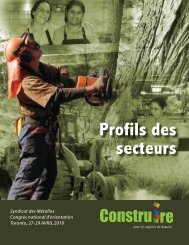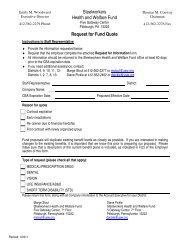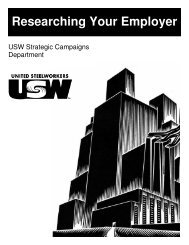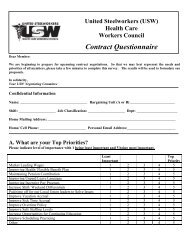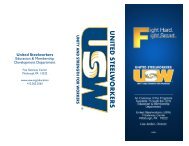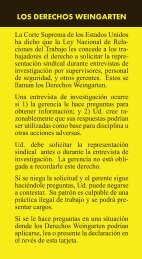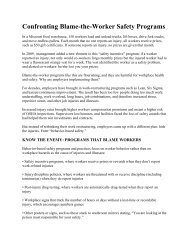Union Approach to Health and Safety: - United Steelworkers
Union Approach to Health and Safety: - United Steelworkers
Union Approach to Health and Safety: - United Steelworkers
Create successful ePaper yourself
Turn your PDF publications into a flip-book with our unique Google optimized e-Paper software.
Section 11(c) of the Occupational <strong>Safety</strong> <strong>and</strong> <strong>Health</strong> Act makes it illegal for employers <strong>to</strong><br />
discriminate against workers who report injuries, complain about job safety, or get<br />
involved in other ways in occupational safety <strong>and</strong> health.<br />
4. If workers think negative job changes will occur if they get involved in health<br />
<strong>and</strong> safety activities, many of them will not get involved.<br />
If taking the time <strong>to</strong> do a task safely is seen by workers as jeopardizing their jobs, then<br />
safety will have a very low priority.<br />
Example -- Protecting against trench cave-ins seen as jeopardizing jobs:<br />
Workers for a municipal water company often dug trenches <strong>to</strong> put in or repair water<br />
lines in a <strong>to</strong>wn. They knew that cave-ins, which could cause serious injury or death,<br />
could be prevented by trench shoring <strong>and</strong> trench boxes. They also knew that the <strong>to</strong>wn<br />
they worked for was very interested in cutting costs.<br />
Management officials never stressed the importance of protecting against cave-ins.<br />
However, they did stress the importance of doing work rapidly <strong>and</strong> they let it be<br />
known that if work was not done in the fastest, least expensive way possible, the <strong>to</strong>wn<br />
would privatize the work.<br />
Private contrac<strong>to</strong>rs rarely used trench shoring devices. In order <strong>to</strong> be “competitive,”<br />
workers believed that they must not dem<strong>and</strong> these protective devices nor the time <strong>to</strong><br />
install them when they dug <strong>and</strong> worked in trenches. If they did, they believed the<br />
<strong>to</strong>wn would privatize their jobs <strong>and</strong> give the jobs <strong>to</strong> outside contrac<strong>to</strong>rs.<br />
In this case, in order <strong>to</strong> get workers involved in dem<strong>and</strong>ing protection against trench<br />
cave-ins, workers needed <strong>to</strong> believe that such dem<strong>and</strong>s would not drive them out of a<br />
job.<br />
Since it is a violation of the Occupational <strong>Safety</strong> <strong>and</strong> <strong>Health</strong> Act <strong>to</strong> work in<br />
improperly shored (or unshored) trenches of a certain depth, one idea was <strong>to</strong> have all<br />
workers call OSHA when they saw contrac<strong>to</strong>rs working in unshored trenches. If<br />
contrac<strong>to</strong>rs felt that they needed <strong>to</strong> spend the time <strong>and</strong> money properly shoring<br />
trenches, they would not be able <strong>to</strong> underbid <strong>to</strong>wn employees who dem<strong>and</strong>ed proper<br />
protections.<br />
5. Some workers do not get involved because they have never been asked or have<br />
never been given a role that they think they can play.<br />
Sometimes the way <strong>to</strong> start getting workers involved is by asking them <strong>to</strong> do something.<br />
That “something” could be filling out a short union survey about the hazards, problems or<br />
health <strong>and</strong> safety concerns on their jobs. It could be asking them <strong>to</strong> a meeting <strong>to</strong> help


